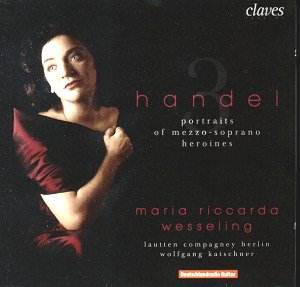This Claves disc does
what many Australian baroque performance
discs do: it intersperses arias with
overtures and ballet music from the
works from which those arias derive.
Of course this isn’t a practice confined
to the Antipodes or to Switzerland but
as a general rule of thumb Anglo-American
Handel discs give the soloist a free
run at his or her repertoire. Sample
recordings by Lorraine Hunt Lieberson
or David Daniels and you’ll invariably
find them giving their all without interspersed
orchestral overtures. Other philosophies
tend to turn the recitatives and arias
into musically cogent sections that
add breadth to the arias that surround
them.
That’s Claves’ way
with this disc from the promising mezzo
Maria Riccarda Wesseling. She is accompanied
by a band well known to Capriccio mavens
and many others besides, the Lautten
Compagney Berlin under conductor Wolfgang
Katschner. The repertoire is not at
all hackneyed and most of the best-known
set-pieces derive from her impersonation
of Dejanira from Hercules. Elsewhere
we have recitatives and arias from Teseo,
in which she sings Medea, and from Radamisto
(as Zenobia); the last named is
certainly due for increased scrutiny.
My checklist of comments
regarding her singing is almost all
favourable. This is a clear, clean and
well-supported voice; divisions are
well taken - O stringerò nel
sen from Teseo for example
– and there is dramatic infusion when
required. Her singing of Morirò
from the same opera is full of compelling
drama and the accompaniment is equally
insightful. She cultivates a true mezzo
in the lower part of her voice, in When
beauty sorrow liv’ry wears for instance,
where one finds her consonants crisp
and her English good if not perfect.
And she demonstrates, even in the confines
of a studio, a talent for "getting
it across" – Where shall I fly!
is a well known vehicle for the delineation
of emotive tension but it still needs
an instinct for inflection and timing
to give it value, and that’s something
Wesseling possesses. As indeed she possesses
surety in her lyric phrasing, something
one can hear in Quando mai from
Radamisto, a first cousin of
Ombra mai fu.
The band shows its
mettle in its solo outings – lithe strings
and flair in the third act Sinfonia
from Hercules are a highlight,
but they perform well throughout. There
are plenty of soprano, mezzo and counter-tenor
Handel recitals that are worthy of a
place on ones shelves and I think this
is another.
Jonathan Woolf







